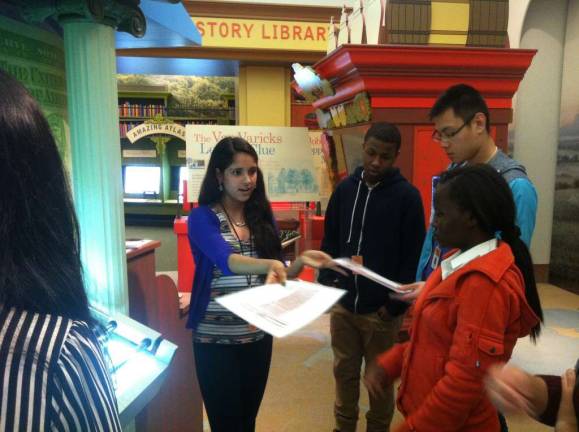WWII Exhibit Shows History in Photographs

Students learn how to research and depict the story of the last 'good' war
Governors Island only became popular in the last 10 years since it was opened and renovated for public use-or so it seems to us present-day New Yorkers. In actuality, the floating arboretum in the middle of New York Harbor played a seminal role in protecting the everyday lives of New Yorkers back in the 1940s. Thanks to an original exhibition put on by the student historians of the New York Historical Society, visitors to Governors Island can journey back to a time when the verdant parkland was the military base standing between the Germans and the Atlantic seaboard.
When one hears New York and World War II in the same sentence, the landmarks that typically spring to mind are Columbia University, the site of the infamous Manhattan Project; or Times Square, the backdrop for the iconic LIFE photograph of the WWII sailor and nurse kissing; or the hundreds of buildings that were temporarily converted into American Red Cross units, including the New York Historical Society itself, which featured these and many more sites in its past exhibit on the Upper West Side, aptly called WWII and NYC, to present a fuller picture of New York's role in the war.
Given the limitations of space in the exhibit, one landmark important to the war effort had to be left out and would have probably evaded notice completely if the museum's education division had not passed on the job to its student historians, an accomplished group of high school students from all five boroughs "with a passion for making history matter," said Chelsea Frosini, managing director of the award-winning program. Working for more than six months on exhaustive object-based research and expert interviews with museum curators and other experts, the students were able to piece together Governors Island's past reputation as the Brooklyn Navy Yard, one of America's foremost suppliers of ships, planes, equipment and soldiers to the Allied cause.
"These kids came in and made their own WWII story. Some of the questions they were asking were ones I hadn't even considered. It was very refreshing for me," says Mike Thornton, a curatorial associate at New York Historical Society, who spent four to five hours one afternoon teaching students about the basics of curatorship.
Jonathan Brown, a student historian since 2011 from Frederick Douglass Academy on West 140th Street, picked up quite a lot of US history from his internship but admits, "I never knew Governors Island was part of the WWII effort before, nor did [the other 12] people in my group, but that's what motivated us to look into it."
In the end, they decided to present their research in an offshoot exhibition of the original NYHS WWII installation that ended in May. Theirs would be a very different kind of exhibit.
The WWII and NYC (Part Two): Photographs and Propaganda is comprised exclusively of old black-and-white images from the era that have been blown up and hung, not in a museum, but in a pre-war mansion on Governors Island that was once used to house military soldiers. The exhibition brought the New York Historical Society not only to Governors Island for the first time, but out of its home on 170 Central Park West for the first time.
The relocation was not without its bumps and hurdles. The Trust for the Governors Island was very specific as to which building they could use, although the house they gave them "was not a safe space but more a military ruin," recalls Mike Thornton. "My gut reaction was 'Why would you dare put people in there, let alone an installation.'"
Yet, Victoria Greene, 17, an Upper West Side student historian who gives tours of the exhibition, along with fourteen other 17-year-olds, recognized early on that "there is something special about showing the objects on the site that holds such a large piece of the WWII puzzle."
Upon visiting House #18 now, you'll recognize the same mustard color exterior and rusty door, but the inside has been completely transformed into a wall-to-wall gallery. "It was very hands-on and very demanding work," recalls Chelsea Frosini, "but our teams of teens and staff all stepped up to the challenge and produced something unprecedented and very exciting!"
The exhibit was also unprecedented in its visitor count. On opening weekend alone, 792 people on Saturday and 832 people on Sunday dropped by to marvel at the sundry photographs, maps, propaganda posters, and advertisements that illustrate New York's physical and moral transformation by the War.
"One poster I return to every time reads 'Americans always fight for liberty,' which really gives you a sense that this was the good war worth fighting for. It makes me proud to be an American," said Brown, who will attend Johns Hopkins University in the fall.
For her part, Greene, a rising senior at Stuyvesant High School, finds herself drawn to the items featuring minority groups, such as a board about a Japanese woman whose nursing application was rejected based on her nationality, or one about an African American man who rose to a high-ranking Army position only to face continued discrimination.
Several of the visitors to the exhibition have been veterans or relatives of veterans with their own stories of the war. As they made their way around the exhibit, they occasionally let out exclamations of glee or sadness upon recognizing one of the photographs.
Thornton points out that, with veterans dying at the rate of 1,000 a day, we are at a "critical cusp" in passing history from first-hand to second-hand knowledge. For this reason, the Student Historians tried to make the exhibit as "educative and participatory" as possible, said Brown.
Visitors are welcome to stop by the exhibition every weekend from June 15 to Sept. 2 to observe the finished product.